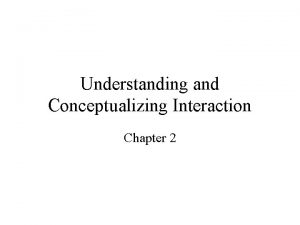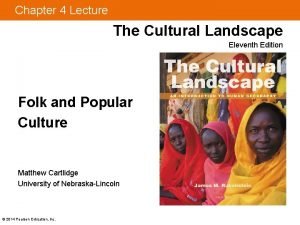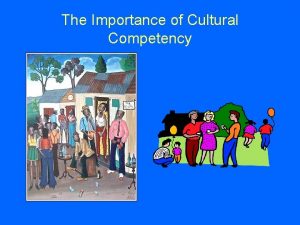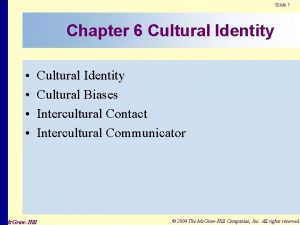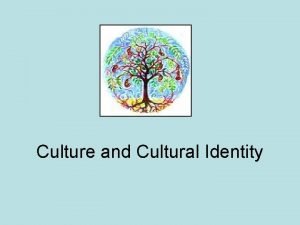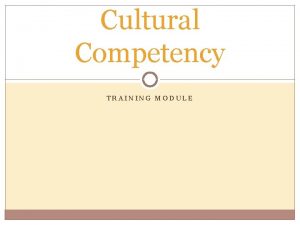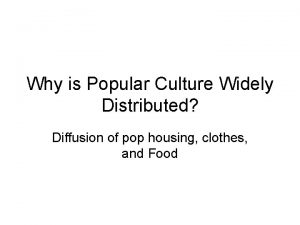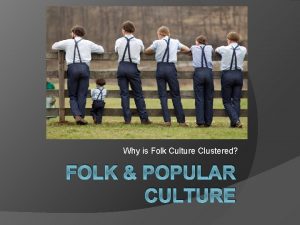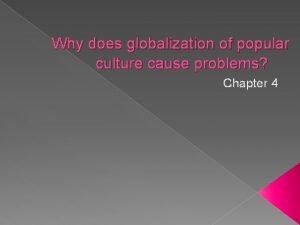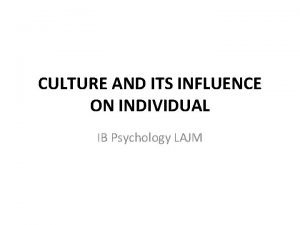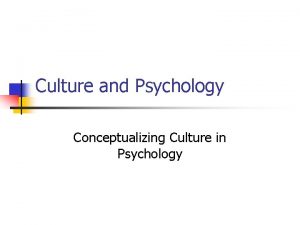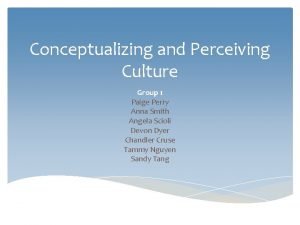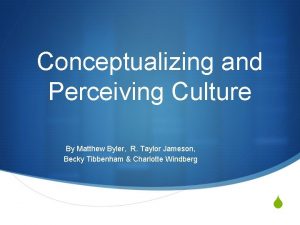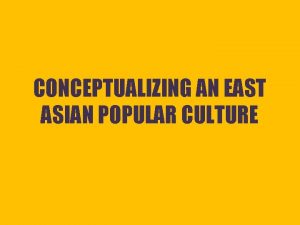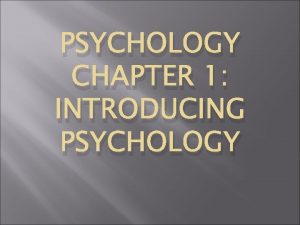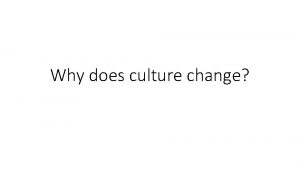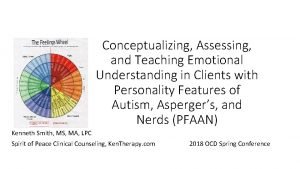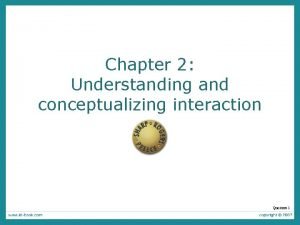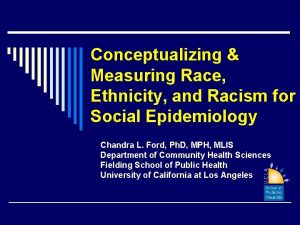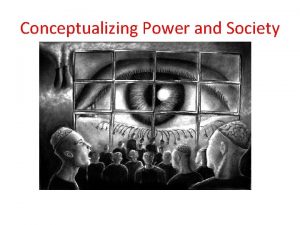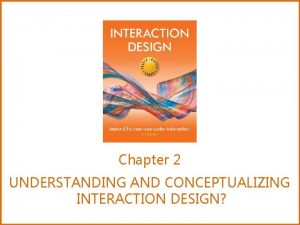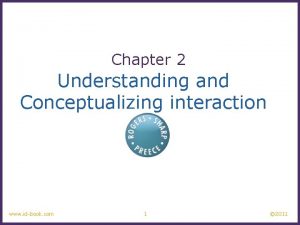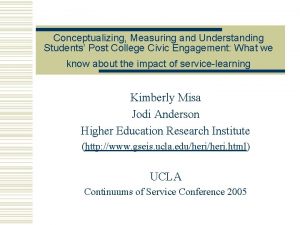Culture and Psychology Conceptualizing Culture in Psychology Why
































- Slides: 32

Culture and Psychology Conceptualizing Culture in Psychology

Why Study Culture in Psychology? n n n To check the generality of psychological research To conduct natural experiments and quasiexperiments To extend understanding of “culture” To understand the process of cultural change To reduce ethnocentrism and promote intercultural understanding.

What is Culture? n Material/Objective Culture n n Buildings, tools, clothing, methods of transportation, etc. Subjective Culture n n Characteristic ways of viewing the environment (e. g. , ideas, theories, and political, religious, scientific, aesthetic, economic, moral and social standards for judging events in the environment. Subjective culture can be institutionalized in government, education, religion, etc. systems.

Defining Culture n n n n Range of activities, phenomena in human life Transmission from generation to generation; accumulated knowledge Socialization/enculturation Implicit and explicit assumptions about life Shared rules to govern activity of a group Patterns of organization Genesis of culture (out of habitat, social interaction, etc. ) A psychological construct

Approaches to the Psychological Study of Culture Absolutism Universalism Relativism

Approaches to the Psychological Study of Culture n Cross-Cultural Psychology n Is concerned with the systematic study of behaviour and experience as it occurs in different cultures, is influenced by culture or results in changes in existing cultures (Triandis, 1980, p. 1)

Approaches to the Psychological Study of Culture n Cultural Psychology n n Is the study of all the things members of different communities think (know, want, feel, value) and do by virtue of being the kinds of beings who are the beneficiaries, guardians and active perpetuators of a particular culture (Shweder et al. , 1998, p. 867) Study of meaning, intentions

Approaches to the Psychological Study of Culture n Indigenous Psychologies n A psychology of a cultural group based on the day-to-day behaviour of its members, for which local points of view provide the paradigms that guide the collection and interpretation of psychological information. (Berry et al. , 2002, pp. 459 -460)

Approaches to the Psychological Study of Culture n Ethnic Minority Psychology n “… is concerned with the use of culturally appropriate methods to understand the behavior and experiences of specific ethnic groups … historically marginalized groups in North America. ” (Goldstein, 2000, p. vii)

Approaches to the Study of Culture n n Culture as as Patterns/Syndromes Intergroup Relations “Border Crossing” a Process

Culture as Patterns (Triandis, 1980) n Cultural Syndromes n A pattern of beliefs, attitudes, selfdefinitions, norms and values that are organized around some theme that can be identified in a society.

Elements of Subjective Culture Knowledge-Related Constructs n Norm-Related Constructs n Self and Social Relationships n Values n

Knowledge-Related Constructs n Schema n n An organized body of information including categories and their associations, stored in memory. Schemata provide structure that help with perceiving, organizing and remembering information, allowing for efficient processing of social information. Beliefs

Norm-Related Constructs n Norms n n Implicit or explicit generalized expectations regarding what is appropriate behaviour for members of a group Kinds of Norms n n Descriptive Prescriptive vs. proscriptive (mores vs. taboos) Institutionalized norms Roles

Values n Values are principles that guide our lives. They are designed to lead us to our ideal world (Schwartz, 1992) n n n Transcend specific situations Guide selection or evaluation of behaviour and events Ordered by relative importance

Value Dimensions (Hofstede, 1980) n n Power Distance n the tendency to see a large social distance between those in the upper part of a social structure and those in the lower part of the social structure. n Control of others’ behaviours Uncertainty Avoidance n Avoidance of situations where the outcome is uncertain n Security, low risk-taking, state religion Masculinity-Femininity n Emphasize differences between men and women n Focus on “achievement” and “success” vs. “interpersonal harmony” or “caring for others and quality of life” Individualism-Collectivism n Tendency to give priority to personal goals even when they conflict with the goals of important groups.

Chinese Culture Connection (1987) n CBC n Integration Human-heartedness Confucian work dynamism Moral discipline n -- n n Hofstede n n n Collectivism Masculinity -Power distance (high) Uncertainty avoidance

Value Dimensions (Schwartz, 1992) Self. Direction Universalism Stimulation Benevolence Hedonism Tradition Achievement Power Conformity Security

Self and Social Relationships n Fiske (1990, 1992) n Communal Sharing n n Authority Ranking n n Distribute resources according to rank Equality Matching n n Share resources according to need Share resources equally Market Pricing n Distribute resources equitably (the more you give, the more you get)

Independent and Interdependent Self. Construals (Markus & Kitayama, 1991) Mother Coworker SELF Friend Mother Coworker SELF Neighbour Independent Interdependent Friend

Independent and Interdependent Self. Construals (Markus & Kitayama, 1991) n Independent n n n Separate from social context Bounded, unitary, stable Internal, private (feelings, thoughts) Life tasks: Be unique, express self, selfactualization Direct communication Self-esteem depends on ability to express self, validate internal attributes n Interdependent n n n Connected with social context Flexible, variable External, public (roles, statuses, relationships) Life tasks: belong, fit-in, engage in appropriate action, promote others’ goals Indirect communication Self esteem depends on ability to adjust, maintain harmony, restrain self

Cousins (1989) Proportion of attributes in self-description

Self-Construals and Emotion (Kitayama, Markus, Kurokawa, & Negishi, 1993) Correlation with general positive feelings

Self-Construals and Motivation (Iyengar & Lepper, 1999) Seconds spent on anagrams during free play

Culture as Intergroup Relations n n Ingroup: The social group to which an individual perceives herself or himself as belonging (“us”). Outgroup: Any group other than the one to which individuals perceive themselves as belonging (“them”).

Culture as Intergroup Relations n 3 Factors Suggested to Explain the Psychological Importance of Ethnicity (Phinney, 1996) n n n Cultural values, attitudes, and behaviours that distinguish ethnic groups Subjective sense of group membership (i. e. , ethnic identity) Experiences associated with minority status (e. g. , powerlessness, prejudice)

Culture as Intergroup Relations n Social Identity Theory (Tajfel, 1978) n n Social categorization Social identity Social comparison Psychological group distinctiveness

Culture as Intergroup Relations, cont. n Social Identity Theory, cont. n Social categorization n The cognitive tendency to divide the social world into categories (i. e. , social groups). This categorical differentiation has the effect of sharpening the distinctions between the categories and blurs the differences within them.

Culture as Intergroup Relations, cont. n Social Identity Theory n Social identity n That part of the individual’s self-concept which derives from knowledge of his or her membership in a social group, together with the value and emotional significance associated to that membership.

Culture as Intergroup Relations, cont. n Social Identity Theory, cont. n Social comparison n The process through which characteristics of the ingroup are compared to those of the outgroup.

Culture as Intergroup Relations, cont. n Social Identity Theory, cont. n Psychological Group Distinctiveness n The state desired by individuals in which the ingroup has an identity that is perceived by the group members as being both distinct and positive vis-à-vis relevant comparison groups.

Reactions of Minority Groups n Social mobility n n Social creativity n n Exit from the disadvantaged group and join a more positively evaluated group. Look for new dimensions of comparison, redefine the current dimension of comparison, or compare with a different outgroup. Social competition n Directly challenge the position of the relatively positively evaluated group.
 Conceptualization interaction
Conceptualization interaction Secondary associations marketing
Secondary associations marketing Andreas carlsson bye bye bye
Andreas carlsson bye bye bye Dont ask
Dont ask Material culture and nonmaterial culture
Material culture and nonmaterial culture Batch culture vs continuous culture
Batch culture vs continuous culture Difference between american culture and indian culture
Difference between american culture and indian culture Uses of selenite f broth
Uses of selenite f broth Folk culture and popular culture venn diagram
Folk culture and popular culture venn diagram Leisure
Leisure Urease test
Urease test Homework due today
Homework due today Lawn culture method
Lawn culture method Explain stab culture and stroke culture
Explain stab culture and stroke culture Surface culture deep culture and esol
Surface culture deep culture and esol Why is access to folk and popular culture unequal
Why is access to folk and popular culture unequal Sociologists define a symbol as
Sociologists define a symbol as Batch culture vs continuous culture
Batch culture vs continuous culture Collectivistic cultures
Collectivistic cultures Subculture group
Subculture group In an inert organizational culture,
In an inert organizational culture, Laying the foundation for a quality culture
Laying the foundation for a quality culture Why is culture important
Why is culture important Why is culture identity important
Why is culture identity important Concept of identity
Concept of identity Cultural sensitivity definition
Cultural sensitivity definition Rapid diffusion of popular culture
Rapid diffusion of popular culture Why is folk culture clustered?
Why is folk culture clustered? Why does globalization of popular culture cause problems?
Why does globalization of popular culture cause problems? What is that ?
What is that ? Cultural dimensions ib psychology
Cultural dimensions ib psychology Why-why analysis
Why-why analysis Willie twister
Willie twister
